Flocculation Behavior of Ultrafine Silica Particles in Acid Leaching Pulp by Nonionic Polymeric Flocculants
Abstract
1. Introduction
2. Experimental
2.1. Materials
2.2. Flocculation Sedimentation Tests
2.3. FBRM Measurement
2.4. Zeta Potential and Effective Diameter Measurements
3. Results and Discussion
3.1. Flocculation Sedimentation
3.2. Flocs Formation and Breakage
3.3. Mechanisms of Flocculation
4. Conclusions
Author Contributions
Funding
Data Availability Statement
Acknowledgments
Conflicts of Interest
References
- Havlik, T. Hydrometallurgy: Principles and Applications; Woodward Publishing: Cambridge, UK, 2014. [Google Scholar]
- Kazadi, D.M.; Groot, D.R.; Steenkamp, J.D.; Pöllmann, H. Control of silica polymerisation during ferromanganese slag sulphuric acid digestion and water leaching. Hydrometallurgy 2016, 166, 214–221. [Google Scholar] [CrossRef]
- Ritcey, G.M. Crud in solvent extraction processing—A review of causes and treatment. Hydrometallurgy 1980, 5, 97–107. [Google Scholar] [CrossRef]
- Fletcher, A.W.; Gage, R.C. Dealing with a siliceous crud problem in solvent extraction. Hydrometallurgy 1985, 15, 5–9. [Google Scholar] [CrossRef]
- Kitchener, J.A. Principles of action of polymeric flocculants. Br. Polym. J. 1972, 4, 217–229. [Google Scholar] [CrossRef]
- Lee, C.S.; Robinson, J.; Chong, M.F. A review on application of flocculants in wastewater treatment. Process Saf. Environ. Prot. 2014, 92, 489–508. [Google Scholar] [CrossRef]
- Hogg, R. Flocculation and dewatering. Int. J. Miner. Process. 2000, 58, 223–236. [Google Scholar] [CrossRef]
- Moud, A.A. Polymer based flocculants: Review of water purification applications. J. Water Process Eng. 2022, 48, 102938. [Google Scholar] [CrossRef]
- Loan, M.; Newman, O.M.G.; Cooper, R.M.G.; Farrow, J.B.; Parkinson, G.M. Defining the Paragoethite process for iron removal in zinc hydrometallurgy. Hydrometallurgy 2006, 81, 104–129. [Google Scholar] [CrossRef]
- Dyer, L.G.; Richmond, W.R.; Fawell, P.D. Simulation of iron oxide/silica precipitation in the paragoethite process for the removal of iron from acidic zinc leach solutions. Hydrometallurgy 2012, 119–120, 47–54. [Google Scholar] [CrossRef]
- Valenzuela-Elgueta, J.; Delgado, A.V.; Ahualli, S. Effect of cationic surfactant addition on the electrokinetics and stability of silica/kaolinite suspensions in copper hydrometallurgy conditions. Miner. Eng. 2021, 169, 106958. [Google Scholar] [CrossRef]
- Figdore, P.E. Adsorption of surfactants on kaolinite: NaCl versus CaCl2 salt effects. J. Colloid Interface Sci. 1982, 87, 500–517. [Google Scholar] [CrossRef]
- Besra, L.; Sengupta, D.K.; Roy, S.K.; Ay, P. Flocculation and dewatering of kaolin suspensions in the presence of polyacrylamide and surfactants. Int. J. Miner. Process. 2002, 66, 203–232. [Google Scholar] [CrossRef]
- Cong, R.; Pelton, R. The influence of PEO/poly(vinyl phenol-co-styrene sulfonate) aqueous complex structure on flocculation. J. Colloid Interface Sci. 2003, 261, 65–73. [Google Scholar] [CrossRef] [PubMed]
- Gaudreault, R.; van de Ven, T.G.M.; Whitehead, M.A. Mechanisms of flocculation with poly(ethylene oxide) and novel cofactors. Colloids Surf. A Physicochem. Eng. Asp. 2005, 268, 131–146. [Google Scholar] [CrossRef]
- van de Ven, T.G.M. Association-induced polymer bridging by poly(ethylene oxide)–cofactor flocculation systems. Adv. Colloid Interface Sci. 2005, 114–115, 147–157. [Google Scholar] [CrossRef] [PubMed]
- Zhou, C.; Tong, D.; Yu, W. 7-Smectite Nanomaterials: Preparation, Properties, and Functional Applications. In Nanomaterials from Clay Minerals; Wang, A., Wang, W., Eds.; Elsevier: Amsterdam, The Netherlands, 2019; pp. 335–364. [Google Scholar]
- Peng, C.; Min, F.; Liu, L. Effect of pH on the adsorption of dodecylamine on montmorillonite: Insights from experiments and molecular dynamics simulations. Appl. Surf. Sci. 2017, 425, 996–1005. [Google Scholar] [CrossRef]
- Emmerich, K.; Koeniger, F.; Kaden, H.; Thissen, P. Microscopic structure and properties of discrete water layer in Na-exchanged montmorillonite. J. Colloid Interface Sci. 2015, 448, 24–31. [Google Scholar] [CrossRef]
- Shi, D.; Yu, W.; Li, R.K.Y.; Ke, Z.; Yin, J. An investigation on the dispersion of montmorillonite (MMT) primary particles in PP matrix. Eur. Polym. J. 2007, 43, 3250–3257. [Google Scholar] [CrossRef]
- Oueslati, W.; Ben Rhaiem, H.; Lanson, B.; Ben Haj Amara, A. Selectivity of Na–montmorillonite in relation with the concentration of bivalent cation (Cu2+, Ca2+, Ni2+) by quantitative analysis of XRD patterns. Appl. Clay Sci. 2009, 43, 224–227. [Google Scholar] [CrossRef]
- Heath, A.; Fawell, P.; And, P.B.; Swift, J. Estimating Average Particle Size by Focused Beam Reflectance Measurement (FBRM). Part. Part. Syst. Charact. 2002, 19, 84–95. [Google Scholar] [CrossRef]
- Grabsch, A.F.; Yahyaei, M.; Fawell, P.D. Number-sensitive particle size measurements for monitoring flocculation responses to different grinding conditions. Miner. Eng. 2020, 145, 106088. [Google Scholar] [CrossRef]
- Kyoda, Y.; Costine, A.D.; Fawell, P.D.; Bellwood, J.; Das, G.K. Using focused beam reflectance measurement (FBRM) to monitor aggregate structures formed in flocculated clay suspensions. Miner. Eng. 2019, 138, 148–160. [Google Scholar] [CrossRef]
- Spicer, P.T.; Pratsinis, S.E.; Raper, J.; Amal, R.; Bushell, G.; Meesters, G. Effect of shear schedule on particle size, density, and structure during flocculation in stirred tanks. Powder Technol. 1998, 97, 26–34. [Google Scholar] [CrossRef]
- Wang, C.; Sun, C.; Liu, Q. Formation, breakage, and re-growth of quartz flocs generated by non-ionic high molecular weight polyacrylamide. Miner. Eng. 2020, 157, 106546. [Google Scholar] [CrossRef]
- Wang, D.; Wang, D.; Deng, C.; Wang, K.; Tan, X.; Liu, Q. Flocculation of quartz by a dual polymer system containing tannic acid and poly(ethylene oxide): Effect of polymer chemistry and hydrodynamic conditions. Chem. Eng. J. 2022, 446, 137403. [Google Scholar] [CrossRef]
- Owen, A.T.; Fawell, P.D.; Swift, J.D.; Labbett, D.M.; Benn, F.A.; Farrow, J.B. Using turbulent pipe flow to study the factors affecting polymer-bridging flocculation of mineral systems. Int. J. Miner. Process. 2008, 87, 90–99. [Google Scholar] [CrossRef]
- Swift, J.D.; Simic, K.; Johnston, R.R.M.; Fawell, P.D.; Farrow, J.B. A study of the polymer flocculation reaction in a linear pipe with a focused beam reflectance measurement probe. Int. J. Miner. Process. 2004, 73, 103–118. [Google Scholar] [CrossRef]
- Huang, Y. Study on Settlement Mechanism of Fine Kaolinite Tailing Ballasteded Flocculation by Quartz Carrier; China University of Mining and Technology: Beijing, China, 2019. [Google Scholar]
- Mpofu, P.; Addai-Mensah, J.; Ralston, J. Flocculation and dewatering behaviour of smectite dispersions: Effect of polymer structure type. Miner. Eng. 2004, 17, 411–423. [Google Scholar] [CrossRef]
- Mpofu, P.; Addai-Mensah, J.; Ralston, J. Investigation of the effect of polymer structure type on flocculation, rheology and dewatering behaviour of kaolinite dispersions. Int. J. Miner. Process. 2003, 71, 247–268. [Google Scholar] [CrossRef]
- Rubio, J.; Kitchener, J.A. The mechanism of adsorption of poly(ethylene oxide) flocculant on silica. J. Colloid Interface Sci. 1976, 57, 132–142. [Google Scholar] [CrossRef]
- Quezada, G.R.; Piceros, E.; Saavedra, J.H.; Robles, P.; Jeldres, R.I. Polymer affinity with quartz (101) surface in saline solutions: A molecular dynamics study. Miner. Eng. 2022, 186, 107750. [Google Scholar] [CrossRef]

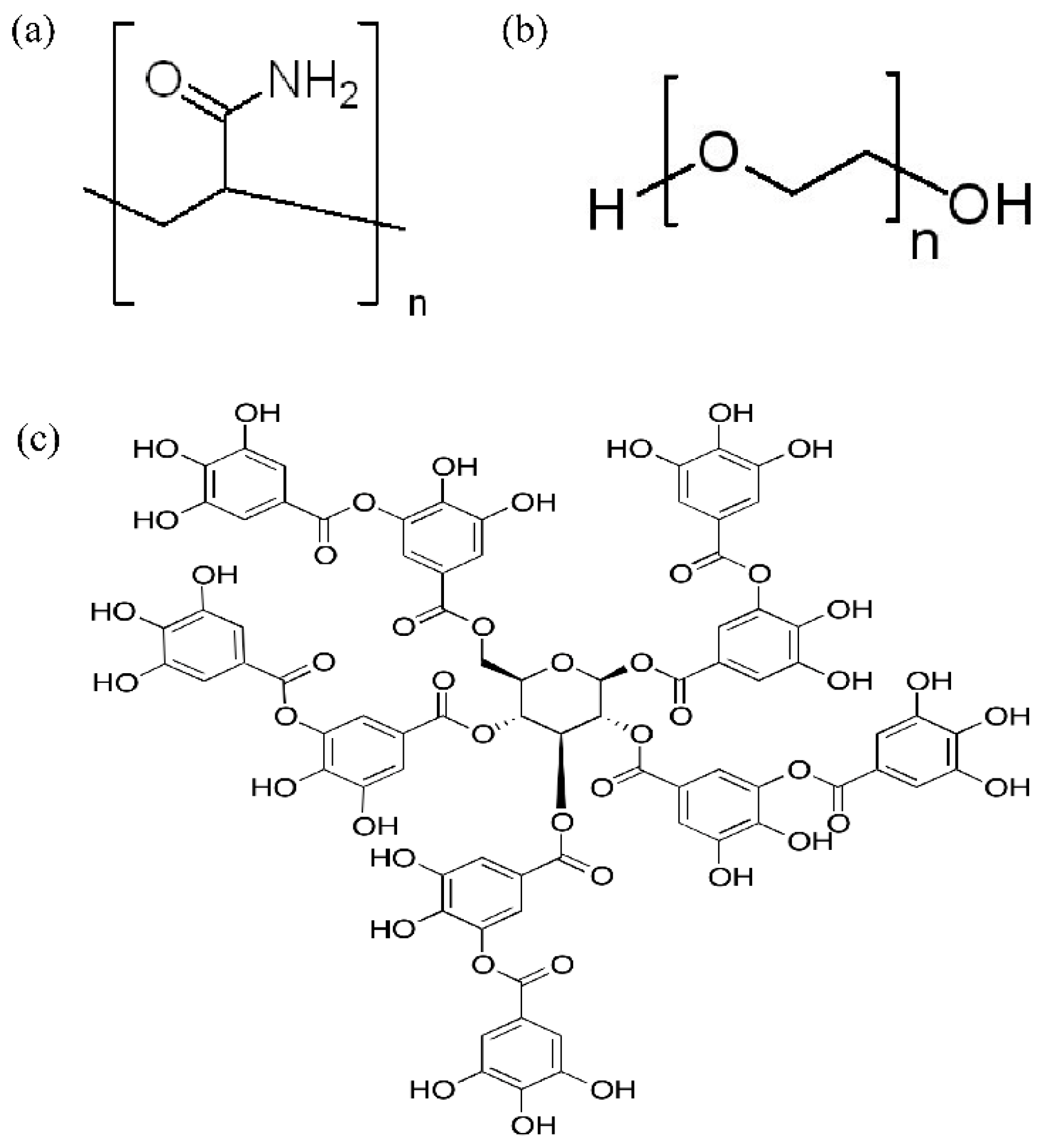
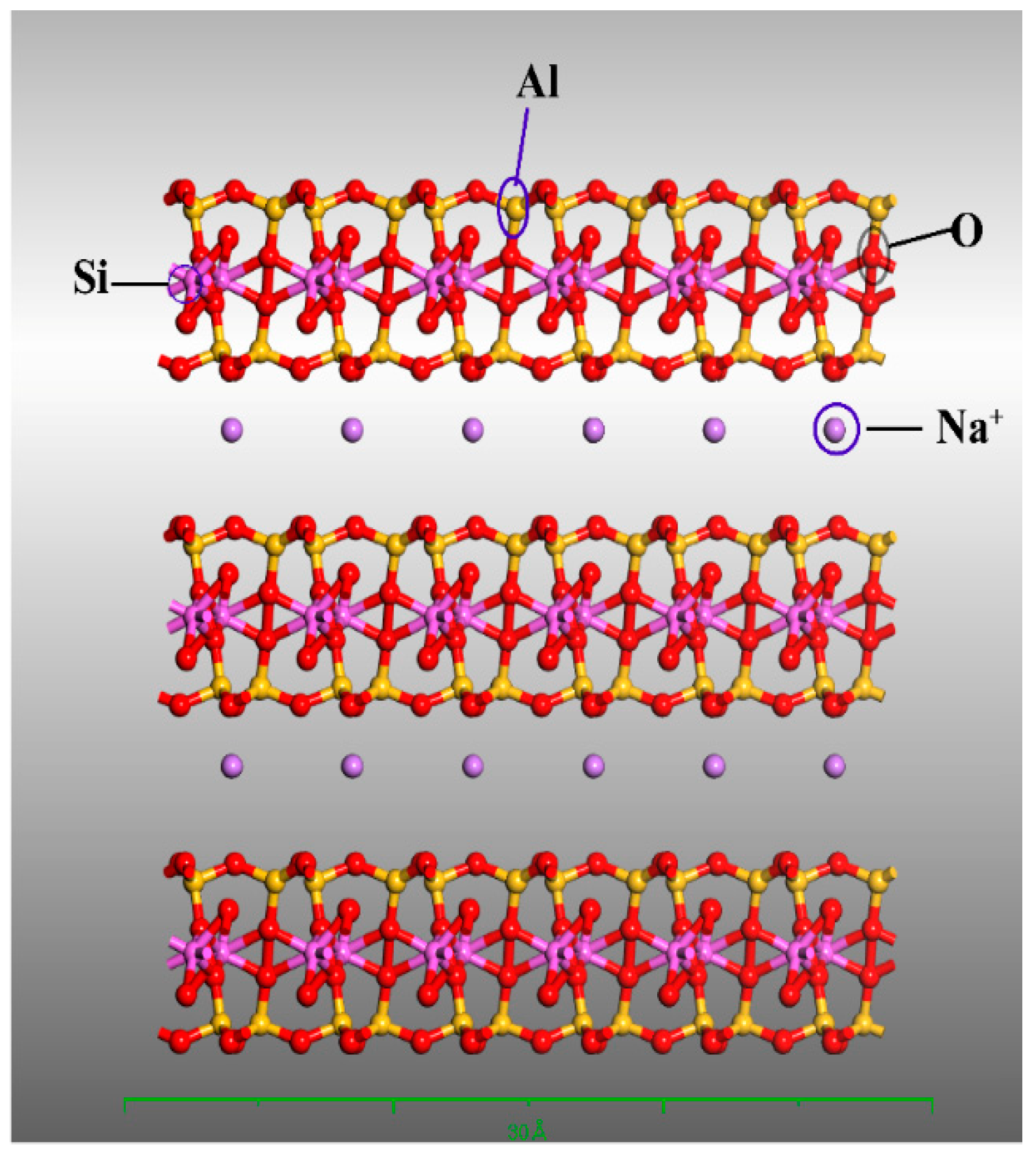




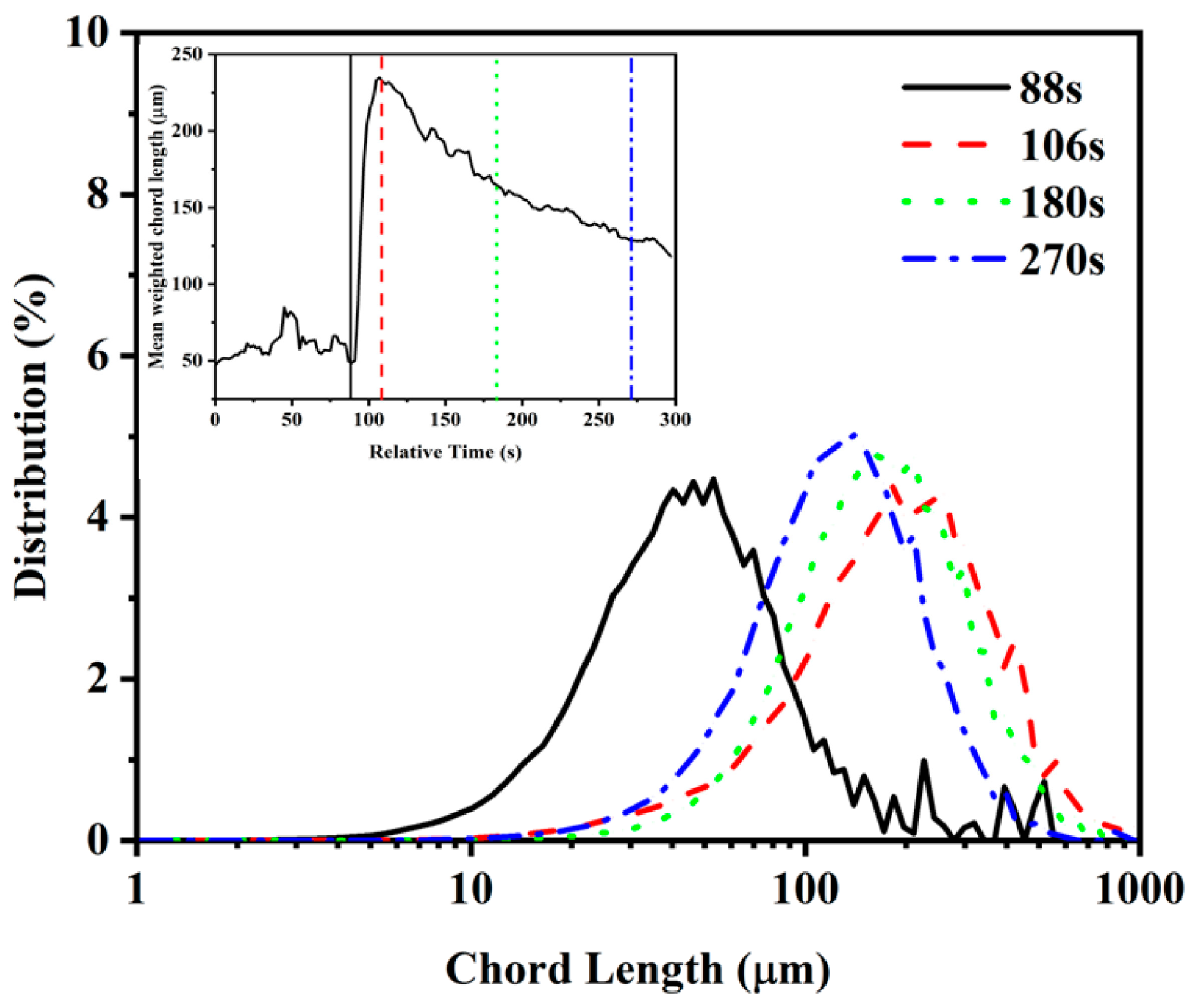
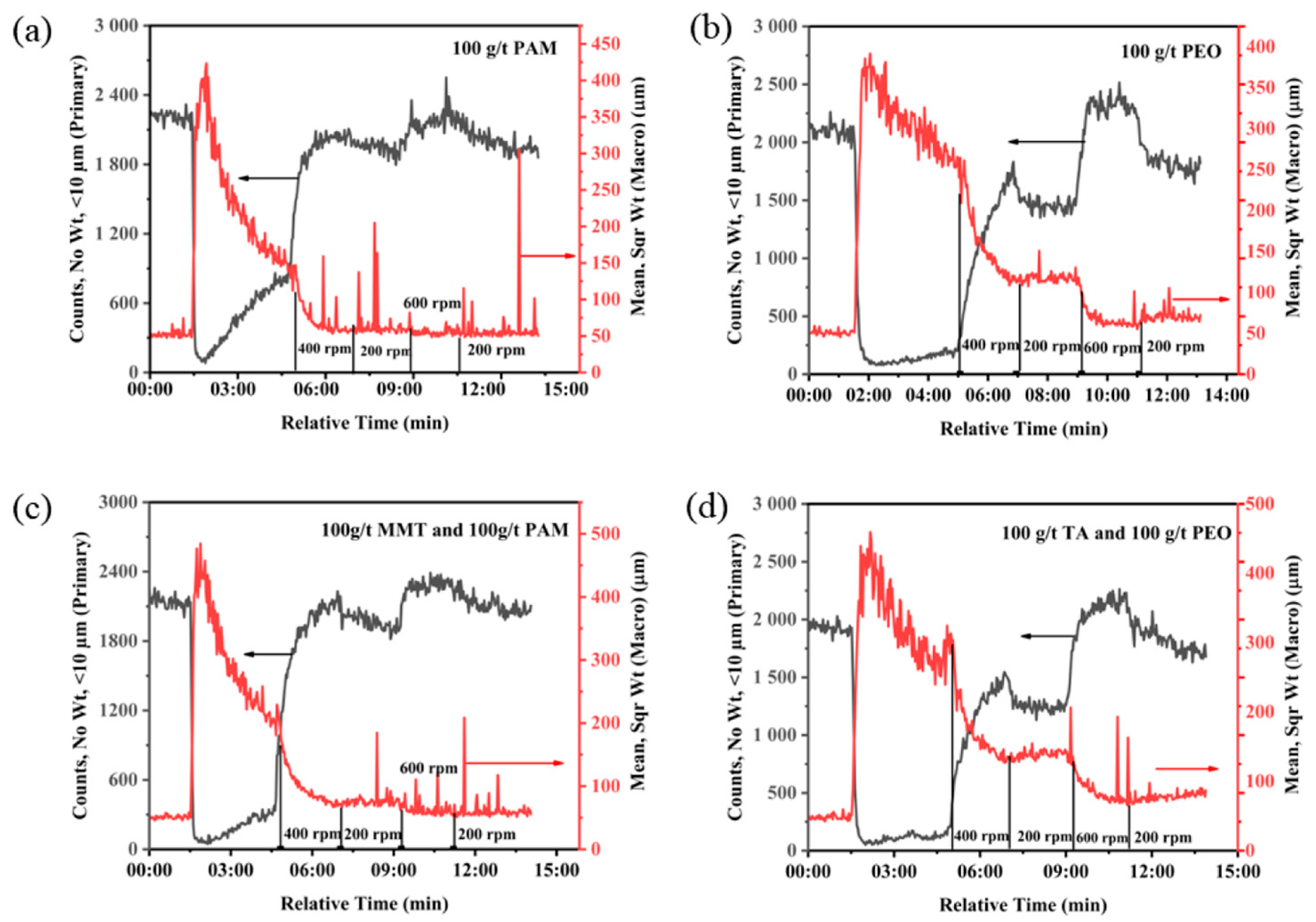
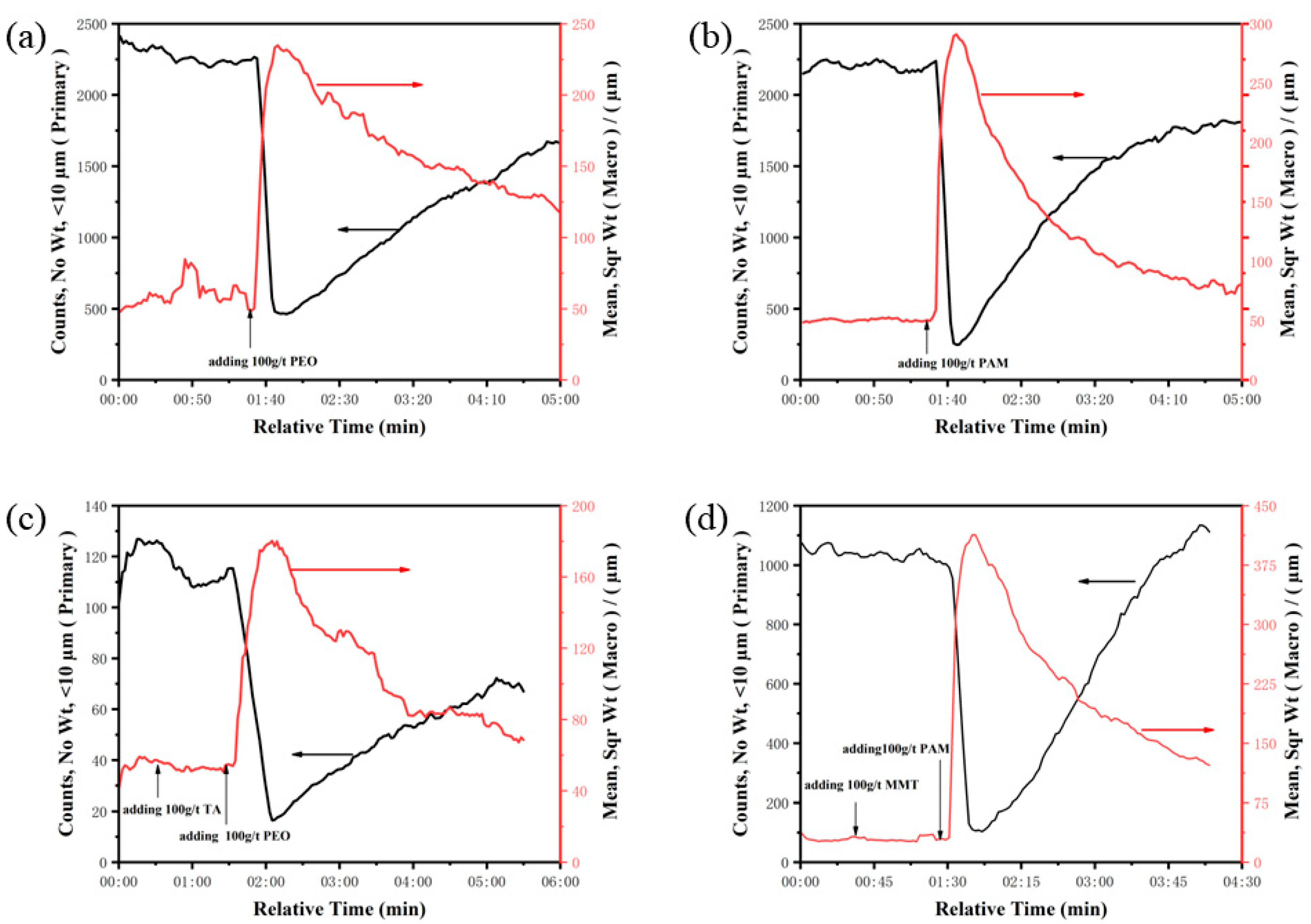

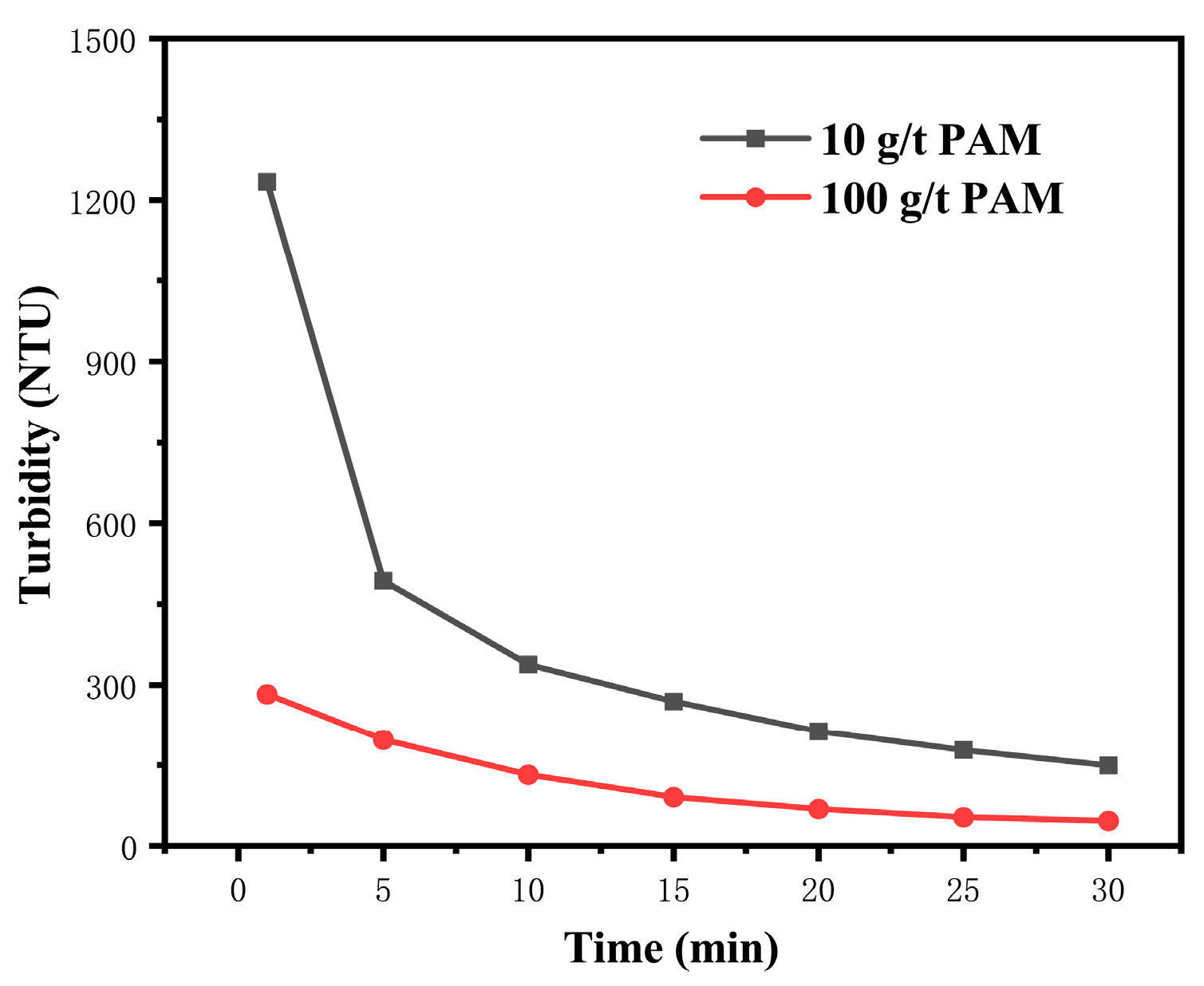
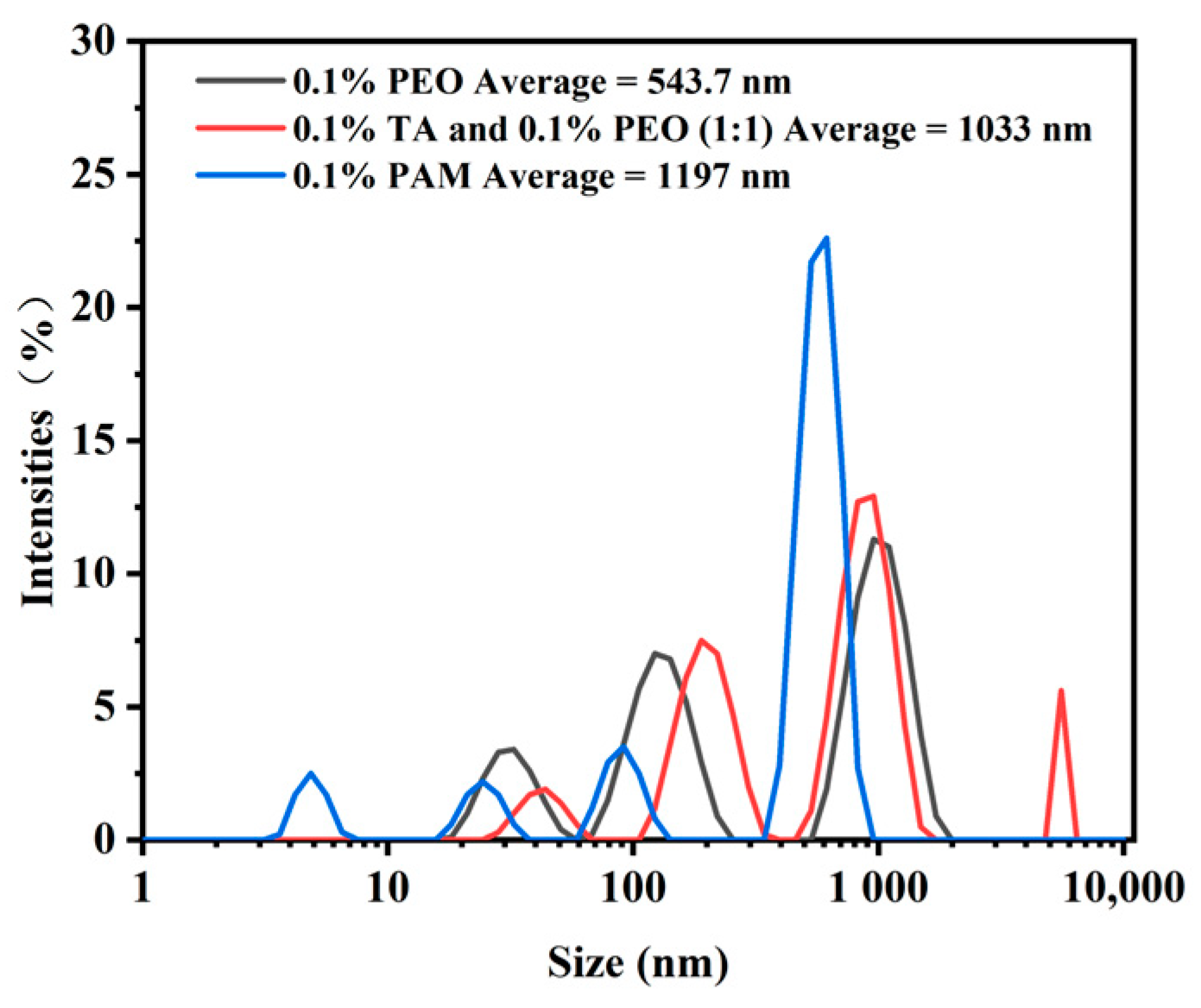

| Molecular Weight, g/mol | Type | |
|---|---|---|
| PEO | 7 million | Powder |
| PAM | 10~12 million | Powder |
| MMT | low | Powder |
| TA | 1701.20 | Powder |
| PAM | PEO | PAM-MMT | PEO-TA | ||
|---|---|---|---|---|---|
| 200 rpm | MPS | −2.08 | −0.76 | −2.25 | −1.27 |
| CFP | 4.92 | 0.45 | 1.42 | 0.49 | |
| 400 rpm | MPS | −1.98 | −0.87 | −2.09 | −0.59 |
| CFP | 13.66 | 7.89 | 14.13 | 7.31 |
Disclaimer/Publisher’s Note: The statements, opinions and data contained in all publications are solely those of the individual author(s) and contributor(s) and not of MDPI and/or the editor(s). MDPI and/or the editor(s) disclaim responsibility for any injury to people or property resulting from any ideas, methods, instructions or products referred to in the content. |
© 2023 by the authors. Licensee MDPI, Basel, Switzerland. This article is an open access article distributed under the terms and conditions of the Creative Commons Attribution (CC BY) license (https://creativecommons.org/licenses/by/4.0/).
Share and Cite
Guo, B.; Zhan, X.; Jiang, K.; Xie, H.; Deng, R. Flocculation Behavior of Ultrafine Silica Particles in Acid Leaching Pulp by Nonionic Polymeric Flocculants. Minerals 2023, 13, 582. https://doi.org/10.3390/min13040582
Guo B, Zhan X, Jiang K, Xie H, Deng R. Flocculation Behavior of Ultrafine Silica Particles in Acid Leaching Pulp by Nonionic Polymeric Flocculants. Minerals. 2023; 13(4):582. https://doi.org/10.3390/min13040582
Chicago/Turabian StyleGuo, Bao, Xinlei Zhan, Kaixi Jiang, Hongzhen Xie, and Rongdong Deng. 2023. "Flocculation Behavior of Ultrafine Silica Particles in Acid Leaching Pulp by Nonionic Polymeric Flocculants" Minerals 13, no. 4: 582. https://doi.org/10.3390/min13040582
APA StyleGuo, B., Zhan, X., Jiang, K., Xie, H., & Deng, R. (2023). Flocculation Behavior of Ultrafine Silica Particles in Acid Leaching Pulp by Nonionic Polymeric Flocculants. Minerals, 13(4), 582. https://doi.org/10.3390/min13040582






